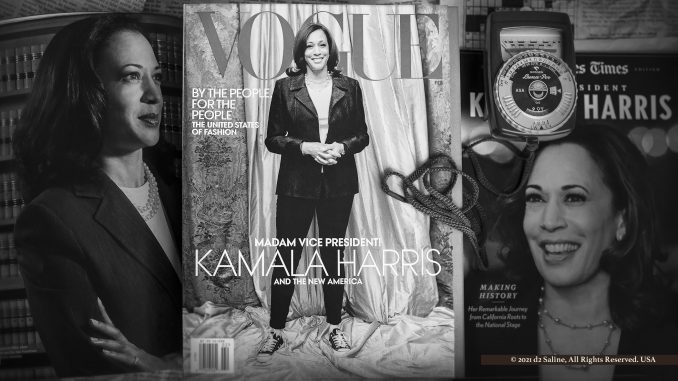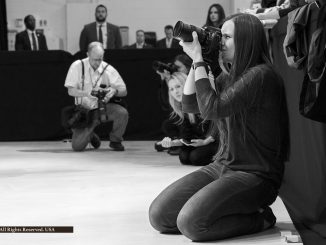
Mid-January, Vogue Magazine revealed its choice for February 2021 issue cover image. “Controversy” was the word used by CBS News to broadly characterize reactions that followed from a number of fronts. [1]
According to reports, two different options had been produced. Both “by famed photographer Tyler Mitchell,” who, at the age of twenty-six, “became the magazine’s first African American photographer to shoot a Vogue cover in the magazine’s over 125-year history when he photographed singer Beyoncé Knowles-Carter for the September 2018 issue …. [2]
‘Aides to Harris and Vogue had the understanding that the blue suit/gold background would be the cover photo. Without telling Harris’ team, Vogue changed it to the pink/green photo which the Vice President-elect’s team did not agree to ….’
“Harris’ team” was said to have felt “blindsided” by this switch in editorial direction.
Assuming there had in fact been an “understanding” here, such arrangements are hardly uncommon, nor are they at all inappropriate. Journalistic integrity and independence remain solidly intact. Because such deals are struck — must necessarily be struck — in recognition that each side gains through these affiliations. [3,4]
That leaves the question of the outrage itself. Was there an underlying legitimacy to the public backlash? Or should this be dismissed as tempermental complaint of the sort too common among overprotective staffers paid to find fault where none is reasonably to be found?
Contributors to CNN Style have come forward to argue the in favor of ther former point of view. They cited Robin Givhan of the Washington Post, who wrote “that while ‘there’s nothing inherently wrong’ with the picture, in selecting the more informal one as its cover, ‘Vogue robbed Harris of her roses.’ [5]
When the [version] which sees Harris wearing a powder blue Michael Kors suit … first emerged last week, social media users described it as ‘presidential’ and ‘more appropriate’ ….
It is an established fact that all photographs are, by definition, manipulated. As noted expert in the field Ben Long has asserted, “They always have been.” [6,7]
When considering this in terms of the African American community, works such as Through A Lens Darkly seek to make clear “that history is inexorably bound to visual representation …, [forcing] the audience to reconsider any preconceived notions it might have about what a photograph is and what a photograph’s place is in society. [8,9]
Who made a photograph, why they made it, and what context it was shown in is just as important as the photograph that wasn’t taken, that wasn’t shown, that hasn’t been preserved for future consideration.
Ten years ago, ad man Tom Burrell was asked to comment about slave auction posters as among the earliest advertisements in the United States, during an NPR interview about his book Brainwashed: Challenging the Myth of Black Inferiority. [10,11]
They’re basically images, images and words. They’re very powerful. Images and words are very powerful, and they conveyed and carried out this whole idea of African-Americans being less than, not as good as: the myth of black inferiority.
… I grew up in the era of the New Deal, and we were very much subjected to learned helplessness. I mean, the idea of our inferiority was played out constantly by reinforcing the thought that we could not take care of ourselves.
And that was played out in the media as we grew up, as I grew up with characters in movies who were buffoons, characters on the radio, whether they be Beulah or Amos and Andy, who were basically servants and clowns. We didn’t see ourselves portrayed in a positive and powerful way growing up, and we basically heard that we were not as good as white people.
This pervaded to the fundamentals of photographic mediums with the advent of color film stock. Plus or minus, date that to 1935, when Kodachrome became “the first commercially successful amateur color film.” In 2017, former President of Pentax US described it as “my first true love,” adding that “when the subject matter warranted the very best image, I’d always shoot with Kodachrome.” [12,13]
Photographer Syreeta McFadden did not enjoy anything like such an experience. [14]
In 1976, “85% of all film cameras and 90% of all film sold in the US was Kodak.” A decade later, Ms McFadden was photographed at the age of twelve: “In some pictures, I am mud brown, in others I’m a blue black. [15]
Some of the pictures were taken within moments of one another. ‘You look like charcoal,’ someone said, and giggled. I felt insulted, but I didn’t have the words for that yet. I just knew that I didn’t want to be seen as a quality of a dark black that would invite hatred on my skin.
In a 2014 interview with NPR, Syreeta McFadden cited the famous Kodak “Shirley Card” as a starting point for the problem. Ubiquitous reliance upon this standard effectively left printers with an erroneous standard for their work — or at best, no frame of reference at all. [16,17]
A lot of [the design of film and motion technology] was conceived with the idea of the best representation of white people. And I don’t mean to say that it was a deliberate and exclusionary practice, but [it was] much more of a willful obliviousness, if you will. So color film in its early stages pretty much developed around trying to measure the image against white skin ….
Kodak Eastman had a model on staff named Shirley, [whom] they used as a human face to meter the printed color stock. So she’s a pale, white-skinned woman [with] dark hair, that’s set against a rather banal background to try and see how white skin fared in a high-contrast light situation. So the Shirley cards became a rubric to set up or establish what would be a much more perfected color image.
By way of bringing the history set out above full circle, the January 19 CNN Style write-up noted that Vogue Magazine had announced that it would be “publishing a limited number of special edition inaugural issues” under the “widely preferred alternative cover, which features [Vice President Kamala Harris] in a light blue suit against a gold background ….”
Sometimes it take more than one round to get to the truth of a matter — even when dealing with photographs straight out of the camera.
References
- “Controversy surrounds Kamala Harris’ first Vogue cover” Timothy Perry (January 11, 2021) CBS News.
- Tyler Mitchell (home page).
- “Why the Media Will Always Cover Celebrities” Larry Atkins (May 25, 2011) HuffPost.
- “Why Celebrities Are Still Dying to Be on Magazine Covers” Rachel Bashein (February 2, 2016) The Cut.
- “Vogue to print alternative Kamala Harris cover following photo backlash” Oscar Holland, with Jacqui Palumbo and Jasmine Wright (January 19, 2021) CNN Style.
- “If ‘the camera never lies,’ how do so many publications manage to put out objectively deceptive photographs?” Dell Deaton (November 4, 2019) Saline Journal.
- “All Photos Are Manipulated” Ben Long (August 3, 2011) Creative Pro.
- Through A Lens Darkly Blog (home page).
- “Through A Lens Darkly: History and Identity in African American Photography” Mia Tramz (February 25, 2014) Time.
- Brainwashed: Challenging the Myth of Black Inferiority Tom Burrell (February 1, 2010) Amazon.
- “Negative Images ‘Brainwash’ African Americans” Neal Conan (March 18, 2010) NPR.
- “The Rise & Fall of Kodak” Andrew Hudson (August 29, 2012) PhotoSecrets.
- “Kodachrome Retrospective – Kodak’s Most Famous Film” James Tocchio (October 4, 2017) Casual Photophile.
- “Teaching The Camera To See My Skin” Syreeta McFadden (April 2, 2014) BuzzFeed.
- “A Brief History of Kodak: The Rise and Fall of a Camera Giant” Michael Zhang (June 14, 2018) PetaPixel.
- “How Kodak’s Shirley Cards Set Photography’s Skin-Toned Standard” Mandalit del Barco (November 13, 2014) NPR.
- “Light And Dark: The Racial Biases That Remain In Photography” Celeste Headlee (April 16, 2014) NPR.



